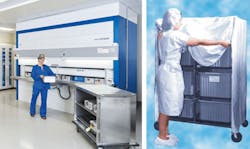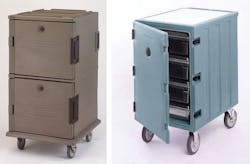Selecting suitable storage and shelving; long sleeves in the SPD
Submit your questions
email: [email protected]
phone: (941) 927-9345 ext. 202
Q I have been the nurse educator for surgical services for the past eight years and recently I was asked to assume the role of director of surgical support services. The sterile processing department has been placed under surgical support services. The manager’s position is vacant and I have had to take on the responsibility of managing sterile processing. Each day I realize more and more how complex this department is and how very little I know about the intricacies of managing this area. We are in the process of renovating the sterile storage area for reprocessed sterile supplies, surgical instruments, and equipment. There is much debate and differing of opinions amongst members of the planning committee regarding the type of storage carts and shelving required. Some feel everything must be covered or enclosed and others believe open systems are perfectly acceptable because the supplies and sets are in wraps or containers. We have to come to an agreement and get the shelving ordered. I would appreciate any advice or information you could provide to help us decide.
A Most packaging does not provide an absolute microbial barrier. Therefore, it is important that environmental contamination be minimized to avoid compromising the sterility of devices during storage. Choosing the appropriate type of shelving and cart will depend upon the environment in which the sterile goods will be stored and/or transported. The goal is to maintain sterility of the goods until the point of final use. Proper materials handling is an essential criteria to sterility maintenance. It is essential to assess the flow of sterile goods and the environs they are exposed to following sterilization, during storage and distribution, and at the point of use. This will help identify and determine the depth and type of protection required to maintain sterility. It is likely that some areas in the storage and distribution chain will have different requirements.
Closed or covered cabinets are preferable for high traffic areas (see Figure 1). When transporting sterile items through non-restricted areas, or between facility locations, special attention should be given to ensuring that sterile items are securely covered and/or contained to protect them from less desirable and uncontrolled environments. There are specially designed transporting carts available to fulfill this need (see Figure 2). Open or wire shelving is suitable for confined storage areas if proper attention is given to traffic control, area ventilation, and housekeeping. Sterile storage areas should be designed specifically to protect all stored sterile supplies from damage and potential contamination. The ventilation system should be designed so that air flows out of the sterile storage area (via positive pressure). Other aspects of ventilation should comply with the guidelines set forth in American Institute of Architects (AIA), 2006, for OR environments. When using wire-rack shelving be sure that the bottom shelf is of a solid material or that the wire shelf is covered by a durable liner. Tote boxes and bins may also be used to protect sterile packages stored in open design shelving.
Q In the December 2016 CS Solutions column the need to wear long sleeves in the sterile processing department was discussed. AORN recommendations were referenced. We follow AAMI standards and I was unable to find anything regarding long-sleeve scrubs in their documents. Could you tell me where I might find that recommendation in AAMI? We are expecting The Joint Commission (TJC) next month and I don’t want to be cited for not following AAMI standards by doing something that AAMI doesn’t say should be done.
A AAMI does not specify or describe scrub attire nor mention long-sleeve jackets. They do however address the need to wear clean, freshly laundered attire every day in sterile processing and to change that attire as necessary throughout the day if the attire becomes soiled. Current AAMI standards do mention the need for proper attire in the sterile prep area, but the standard does not provide any specifics other than to state “take necessary precautions relative to attire — as established by hospital policy.” AAMI documents do make reference to various AORN recommendations. As was stated in the December CS solutions column (https://www.hpnonline.com/loathing-long-sleeves-sorting-soiled-linens-the-purpose-of-enzyme-spray-handling-heavy-sets/), AORN documents and guidelines do address the need to wear long sleeves and states the rationale for this recommendation. You can find the AORN guidelines at https://www.aorn.org/guidelines/clinical-resources/clinical-faqs/attire.
CS professionals need to keep current and stay abreast on issues by reviewing the most recent professional journals, literature, studies and new technology. The healthcare environment is dynamic, new discoveries and changes occur frequently. Managers must keep current on issues and adapt policies and procedures accordingly. To maintain best practices for patient and worker safety, decisions need to be based on sound data and good judgement. AAMI documents do not say not to wear long sleeves or warmup jackets but it is also essential to consider the most current information. AORN’s response and recommendations are more recent than the current (published) AAMI standards. AORN recommendations are also evidenced-based. If you decide to enforce long sleeve attire in the sterile processing area you would not be in violation of AAMI standards. Your decision would be based on current and sound information. We might see this issue addressed in later editions of AAMI docs.

Ray Taurasi
Ray Taurasi is Principal, Healthcare CS Solutions. His healthcare career spans over five decades as an Administrator, Educator, Technologist and Consultant. He is a member of AORN, SGNA, AAMI and a past president of IAHCSMM. Taurasi has been a faculty member of numerous colleges teaching in the divisions of business administration, nursing, and health sciences. He is the author of numerous articles and textbook chapters; he is a frequent speaker at national and international healthcare conferences.
Note to readers from Ray Taurasi - In 2021, my life’s career path will transition to one of new opportunities and adventures. As a result, after nearly 19 years and 225 CS Solution columns, this edition will be my last.
“All changes, even the most longed for, have their melancholy; for what we leave behind us is a part of ourselves; we must die to one life before we can enter another.”– Anatole France
I wish you and your loved ones a healthy and joyful holiday season and a beautiful New Year! God Speed, Ray
https://www.facebook.com/pages/category/ Local-Business/Healthcare-CS-Solutions-128857 3061153887/ • email: [email protected]







